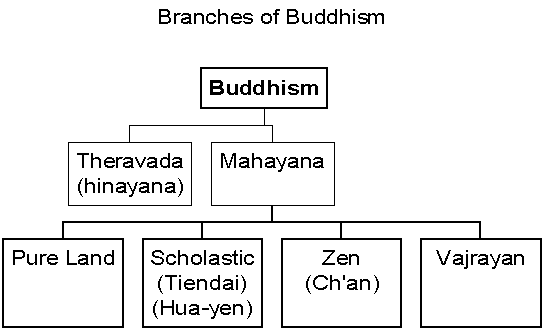|

Buddhism
divides into two main branches: Theravada and Mahayana. It is possible to understand Pure Land, Zen, Vajrayan and
Nichiren as sub-groups of Mahayana since they all developed from Mahayana
Buddhism.
A. Theravada (“way of
the elders”) also
referred to as hinayana (lesser vehicle)
1. Scriptures:
The
Pali Canon – also known as the Tipitaka – three baskets
·
In the Pali dialect
·
Written down in first century BCE
Jataka
Tales
·
547 folk tales
2. The Triple Gem
1.
I take refuge in the Buddha – honors rather than worships
2.
I take refuge in the dharma – the teachings of the Buddha
3.
I take refuge in the sangha – monastic community of
Buddhism
3.
Vipassana Meditation
Mindfulness/insight meditation
Purpose is to perceive the truths of existence – i.e. dukkha,
anicca and anatta
4. The Laity
Theravada Buddhism is generally a
path for monks and nuns rather than the laity.
Nevertheless, lay
people participate in Theravada Buddhism through:
·
Veneration of relics thought to be from the Buddha and
housed in stupas
·
Learning from monks and nuns
·
Giving alms to support the sangha.
B. Mahayana (the “greater
vehicle”)
More extensive sacred writings than Theravada
Encompasses monks and laity
Many subdivisions/schools within Mahayana
Common Characteristics of Mahayana include:
1. Bodhisattvas
·
Seek enlightenment for the sake of others.
·
Both laity and monastics take vow to become bodhisattvas:
§
Beings are infinite in number, I vow to save them all;
§
The obstructive passions are endless in number; I vow
to end them all;
§
The teachings for saving others are countless, I vow
to learn them all:
§
Buddhahood is the supreme achievement: I vow to
attain it.
·
Heavenly bodhisattvas hear pleas of the suffering
One
of the most important is Kuan-yin (Kannon)
2. The Three Bodies of
the Buddha
Buddha is an eternal presence with three aspects or bodies
·
Pure universal consciousness
·
Body of bliss “radiant celestial aspect of Buddhahood that
communicated the dharma to Bodhisattvas
·
Body of transformation –Siddhartha Gautama
3. Emptiness (Sunyata)
-
All
earthly things have no eternal reality/independent origin
-
Thus
world of samsara is empty of inherent existence
-
Five
aggregates of a person are empty of absolute self-nature; exist only
in relation to other.
|